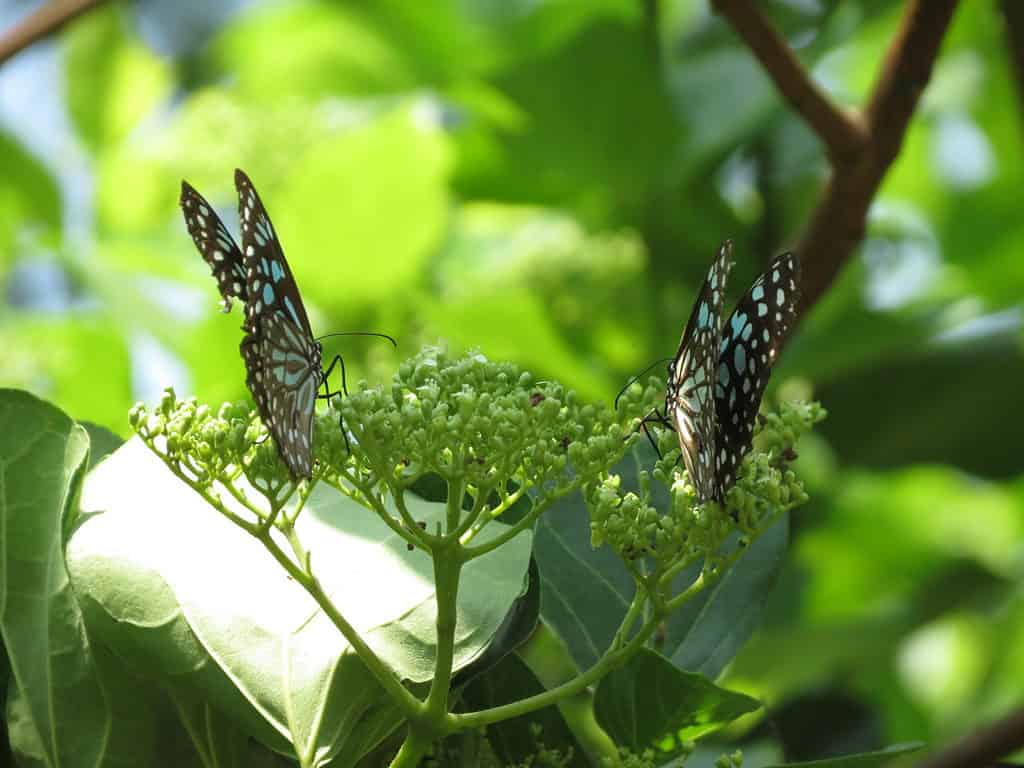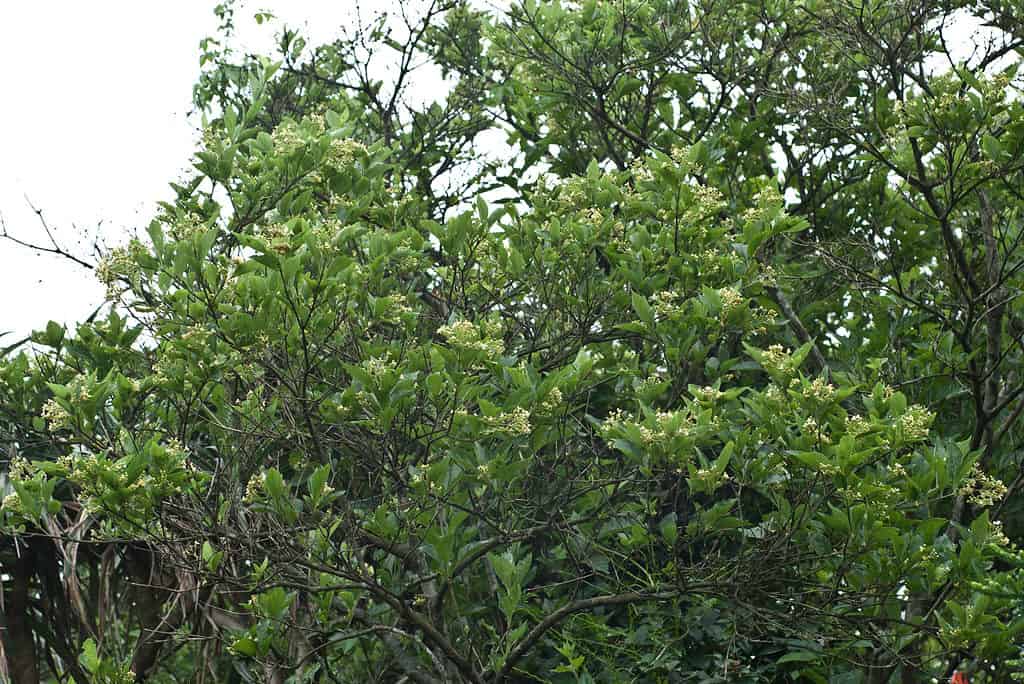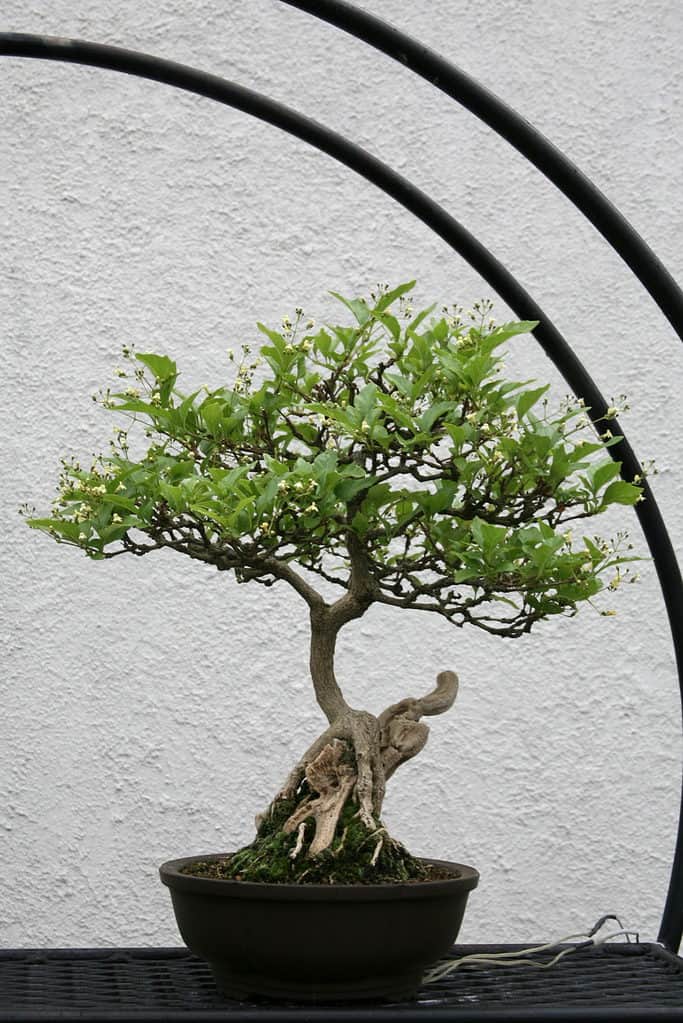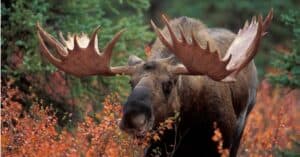Premna trees are prized around the world for their medicinal and even culinary uses. They have been used for centuries to cure many different ailments. In addition, they are also beloved as bonsai trees! Because of their small stature, dense branch systems, and adaptability, Premna trees have been used in bonsai art for a long time.
Here is everything you need to know about caring for a Premna Bonsai tree!
| Botanical Name | Premna |
| Common Types | Premna acuminata, Premna serratifolia, Premna microphylla, Premna obtusifolia |
| Sunlight | Full sun, though some species can tolerate partial shade. Small or weak Premna bonsai trees should be kept away from direct midday sunlight during the summer. |
| Soil | Well-draining. Premna bonsai trees are adaptable and can tolerate most specialty bonsai tree soil mixes. |
| Water | Regular watering to keep soil and rootball from drying out completely. |
| For Beginners? | Yes! Premna bonsai trees are easy to care for, easy to prune, and easy to style. |
| Indoors or Outdoors? | Outdoors year-round in warm, humid climates. Indoors in extreme hot or extreme cold, especially when conditions are dry. |
| Pairs Well With… | Rocks and moss, other natural ornamentation. |
Common Types of Premna Bonsai Trees
There are over 200 different species of Premna trees. Some of the most common are Premna acuminata, Premna serratifolia, Premna microphylla, and Premna obtusifolia. Each of these species would be perfect for Bonsai tree art!
Read on to learn about the common types of Premna bonsai trees!
Premna acuminata
Also known as firestick tree, Premna acuminata is native to the continent of Australia! The wood, sticks, and twigs from these shrubs is often used in fires.
The leaves are fine in texture with thin hairs spreading across the face. In the spring and summer, these shrubs flower. Eventually, these white, aromatic flowers give way to berries that are dark in color.
Fast-growing, Premna acuminata trees can tolerate partial shade and only need a moderate amount of water in order to grow their best.

is native to the continent of Australia where it is also known as firestick tree.
©Centre for National Biodiversity Research, CC BY 4.0 <https://creativecommons.org/licenses/by/4.0>, via Wikimedia Commons – Original / License
Premna serratifolia
The native range of Premna serratifolia trees is widespread. They can be found in tropical and subtropical climates from East Africa to the Pacific. Premna serratifolia trees flower throughout late spring well into the autumn months. The general range is May to November. During this time, these aromatic flowers attract bees, butterflies, and other insects.
One thing that separates Premna serratifolia from other Premna species is the fact that the leaves on these shrubs are smaller. This actually makes them perfect for bonsai tree art!
Another aspect of Premna serratifolia that makes them well-suited to bonsai tree art are their branches. The branch system of a Premna serratifolia tree is dense. This can lend to some really beautiful and dramatic bonsai tree art!
A Premna serratifolia thrives when planted in moist, sandy soil. They can grow beneath full sun as well as in partial shade. These trees are fast-growing like other Premna varieties. The serratifolia species has strong roots that allows them to stay healthy while growing quickly. In fact, Premna serratifolia are known for their thick, strong trunks.

The aromatic flowers of
Premna serratifoliaattract bees, butterflies, and other insects.
©Forestowlet, CC0, via Wikimedia Commons – Original / License
Premna microphylla
The Premna microphylla tree is also known as the Japanese musk maple tree. They are native to eastern Asia. In the wild, they are often found in forests, growing on mountainsides.
The flowers on a Premna microphylla bloom throughout the summer months. Generally, they begin blooming in June and continue blooming through September. During the end of this period, a Premna microphylla also begins to develop fruit. This fruit is usually dark purple in color.
Similarly to a Premna serratifolia, the leaves on a Premna microphylla are small. In fact, the name “microphylla” means small leaves! Because of this, Premna microphylla are also suited to bonsai tree art.
To really thrive, a Premna microphylla needs full sun for at least six hours a day.

is suited to bonsai tree art because of its small leaves.
©Shih-Shiuan Kao, CC BY-SA 2.0 <https://creativecommons.org/licenses/by-sa/2.0>, via Wikimedia Commons – Original / License
Premna obtusifolia
Premna of the obtusifolia species are often found on the coast of their native regions. Most other species of Premna grow in forests and mountains in the wild.
Premna obtusifolia are prized around the world as bonsai trees. In addition to this, they also have many medical uses. Across local cultures, they are beloved for this reason. Premna obtusifolia trees – whether it is the fruit, leaves, or bark – can be used to treat many different ailments. The most common are coughs, skin diseases, issues with the eyes, and stomachaches and pains.
Caring for one of these wonderful trees isn’t difficult. Since Premna obtusifolia trees dry out quickly, they need to be watered regularly. This need only increases when a Premna obtusifolia is being grown as a bonsai tree. But we’ll go more into depth on how to water your Premna bonsai tree below. To thrive a Premna obtusifolia needs full sun. They can tolerate partial shade, however.
Caring for Your Premna Bonsai Tree
Just like most other trees and plants, Premna trees are picky about some things. Other things, they don’t care about as much. As a whole, though, Premna trees are relatively easy to care for. This does not change much when they are planted as bonsai trees. Whereas most plants weaken when they are planted in bonsai tree containers, Premna trees do not. They are used to being planted in containers, whether for bonsai tree art or not!
Read on to discover everything you need to know to care for your Premna bonsai tree so that it can thrive!

trees are used to being planted in containers, whether for bonsai tree art or not!
©Cliff from Arlington, Virginia, USA, CC BY 2.0 <https://creativecommons.org/licenses/by/2.0>, via Wikimedia Commons – Original / License
Sunlight
Since Premna trees are used to tropical and subtropical climates and conditions, they are also used to full sun. Full sun means keeping a plant beneath direct sunlight for at least six, generally uninterrupted, hours every day. Some Premna trees can tolerate partial shade. But to really help these sun-loving plants thrive, it is best to give them as much sunlight as possible!
If you plan to grow your Premna bonsai tree indoors, make sure to replace the sensation of full sunshine with grow lights!
Soil Type
For the most part, Premna trees are not overwhelmingly picky about what type of soil they grow in. They often can be found growing in rocky conditions in the wild, but they can thrive in most soil conditions.
Bonsai trees generally need a specialty bonsai tree soil mix. In addition to being designed as well-draining – which is a need for every bonsai tree, including a Premna – these mixes are often made with pumice, lava rock, akadama, grit, and organic compost matter. Not every mix has all of these components in its recipe, so it can be a good idea to understand what each of these components are and what they do for bonsai trees.
Water
Across the board, Premna plants are fast-growing. This means that they often need a decent amount of water regularly to ensure strong and proper growth. Since they are being grown as bonsai trees, extra care needs to be taken to keep the rootball from growing out. If it can be managed, too, try to not let the soil completely dry out either.
Placement
Since Premna trees are used to tropical and subtropical climates in the wild, it is important to replicate these conditions as best as possible when growing Premna as a bonsai tree. This means placing your Premna bonsai tree in conditions that are warm and humid. However, even after being placed in these conditions, a Premna bonsai tree still needs attention throughout the year.
Premna bonsai trees often cannot tolerate extreme hot or extreme cold. Particularly small or weak Premna need to be protected from the hot midday sun, especially in the summer months, because they can dry out much quicker.
Certain Premna bonsai trees can tolerate cold temperatures for a short period of time, like the obtusifolia species, but for the most part a Premna bonsai tree should be brought indoors when temperatures grow too cold outside. During this period, they can be grown beneath grow lights to replicate the sunshine they need!
Pruning Your Premna Bonsai Tree
The best time to prune the large branches of a Premna bonsai tree is in the summer. This is because the wounds that occur from cutting heal faster when the tree is growing. Pruning new shoots should only be done when five or six pairs of leaves have grown. When this happens, prune these shoots to only one or two pairs of leaves.
For the most part, Premna bonsai trees can be wired at any point during the year. If your Premna bonsai tree is a deciduous species, it is best to wire them once all of their leaves have dropped. Wiring young Premna bonsai trees is also possible. Just make sure to remove the wires before the trunk and branches begin to thicken!
Ideal Premna Bonsai Tree Styles
There are many different bonsai tree styles that would suit a Premna bonsai!
Because of their strong, thick trunk the most popular style for a Premna bonsai is the Chokkan style. Otherwise known as the formal upright style, the Chokkan style is probably the most popular for any bonsai tree. It involves keeping the single trunk of your bonsai tree straight and allowing a cluster of branches to grow near the top.
Since Premna trees are so strong and flexible, they can also be shaped and styled into other, more challenging styles.
One these styles is the Moyogi style. This is also known as the informal upright style. Like the Chokkan style, it has one single trunk that grows upright. However, this trunk is shaped so that it bends. At each of these bends, there is often a branch or a cluster of branches growing.

A
Premnabonsai grown using the Moyogi style has one single trunk that grows upright with bends and clusters of branches at each bend.
©iStock.com/photohomepage
Propagating Your Premna Bonsai Tree
There are a variety of ways in which you can propagate a Premna bonsai tree. Growing from seeds and cuttings are popular and easy. More challenging is the process of air-layering.
Air-layering involves wrapping moist sphagnum moss around a section of a specific plant. Generally the section being wrapped should be wounded in some way. The moss can be kept in place with plant twine or floral ties. The next step is to cover the entire area with plastic wrap. This locks in the moisture so the plant can propagate.
Common Problems with Premna Bonsai Trees
For the most part, Premna bonsai trees are hardy and resistant to many diseases and pests. It has been known for Premna bonsai trees to occasionally be infested with aphids or spider mites. To combat these issues, you can use a pesticide designed for the specific problem you are facing!
Up Next
Thank you for reading! Have some feedback for us? Contact the AZ Animals editorial team.








